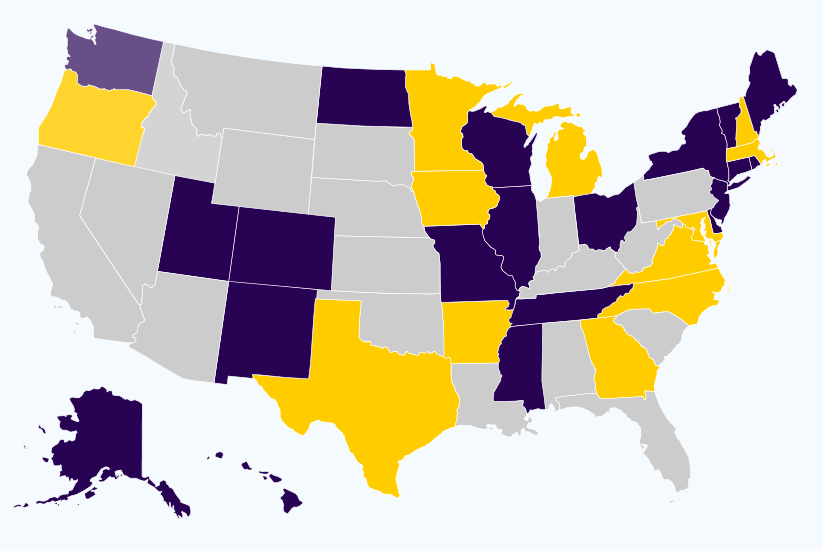|
Spring, Issue #10
News from Act Early Network Partners The 2016-18 Act Early Ambassadors are Agents of Change for Increasing Developmental Monitoring
 The 2016-18 cohort of 45 Ambassadors representing 41 U.S. states and three territories commenced their first program year collaborating together at their annual Act Early Ambassador training at the CDC. Twenty-two returning Ambassadors, from the 2014-16 cohort, enthusiastically welcomed 23 new Act Early Ambassadors during the June 2016 training, as they shared best practices and innovative activities and products to increase developmental monitoring and screening. Throughout the two day training, the Ambassadors gained knowledge and strategies on reaching critical gatekeepers including physicians and early educators, what parents need to practice developmental monitoring, and how the Action Learning Model can assist them in reflecting and improving their state workplan activities. The 2016-18 cohort of 45 Ambassadors representing 41 U.S. states and three territories commenced their first program year collaborating together at their annual Act Early Ambassador training at the CDC. Twenty-two returning Ambassadors, from the 2014-16 cohort, enthusiastically welcomed 23 new Act Early Ambassadors during the June 2016 training, as they shared best practices and innovative activities and products to increase developmental monitoring and screening. Throughout the two day training, the Ambassadors gained knowledge and strategies on reaching critical gatekeepers including physicians and early educators, what parents need to practice developmental monitoring, and how the Action Learning Model can assist them in reflecting and improving their state workplan activities.
The Act Early Ambassador program is a collaborative effort on behalf of the Centers for Disease Control and Prevention's (CDC) National Center on Birth Defects and Developmental Disabilities (NCBDDD), the Health Resources and Services Administration's (HRSA) Maternal and Child Health Bureau (MCHB), the Association of University Centers on Disabilities (AUCD), and the Association of Maternal and Child Health Programs (AMCHP). Act Early Ambassadors serve as liaisons to the "Learn the Signs. Act Early." Program and work as community champions with programs that serve young children and their parents, such as Head Start, Early Head Start, WIC, home visiting, and others. They also work with health care, early education, and child care professionals to improve early identification of developmental disabilities. For more information on the Act Early Ambassadors, please click here.
Announcing New 2016-18 Developmental Monitoring Within State Systems Grantees!
 In April, 12 jurisdictions were awarded 2016-18 Developmental Monitoring with State Systems grants, including two first time recipients - Guam and the Virgin Islands. Other recipients were: California, Florida, Georgia, Massachusetts, Minnesota, Montana, New Mexico, North Carolina, South Carolina, and Tennessee. The State Systems grants are for a two-year period and are designed to increase parent-engaged developmental monitoring by promoting the adoption and integration of LTSAE materials and training resources into programs and statewide systems that serve young children and their families. Each state or territory's project spans a variety of systems such as Home Visiting, Title V, Head Start/Early Head Start, Early Childhood Education Partners and more to increase parent engaged developmental monitoring. To learn more about each grantee's goals, activity areas, and teams, check out AMCHP's 2016-18 LTSAE Overview document here. In April, 12 jurisdictions were awarded 2016-18 Developmental Monitoring with State Systems grants, including two first time recipients - Guam and the Virgin Islands. Other recipients were: California, Florida, Georgia, Massachusetts, Minnesota, Montana, New Mexico, North Carolina, South Carolina, and Tennessee. The State Systems grants are for a two-year period and are designed to increase parent-engaged developmental monitoring by promoting the adoption and integration of LTSAE materials and training resources into programs and statewide systems that serve young children and their families. Each state or territory's project spans a variety of systems such as Home Visiting, Title V, Head Start/Early Head Start, Early Childhood Education Partners and more to increase parent engaged developmental monitoring. To learn more about each grantee's goals, activity areas, and teams, check out AMCHP's 2016-18 LTSAE Overview document here.
State Title V MCH Programs NPMs and ESMs for Child Health
 This July, State Title V (MCH) programs submit their applications and annual report. In this year's document, states will include the unique state performance measures they developed and the newly required Evidence-based or informed Strategy Measures (ESM). For each of the eight National Performance Measures the state reports upon, at least one ESM is developed. The ESM is a short - term measure that shows directly how MCH activity and funding impacts outcomes related to a national performance measure (interim impact) and over time is linked to a national outcome measure (comprehensive, long-term impact). Also in these applications, are the states action plans that describe how they will achieve improvement in all the measures for which they report. The action plans and measurement may be a map for your partnership with the MCH program in your state. You may contact your MCH - CYSHCN Director team by locating their emails on the first URL that follows: https://mchb.tvisdata.hrsa.gov/Home/StateSnapshot. The full applications/annual report will be publicly available late this fall on the TVIS website home page. This July, State Title V (MCH) programs submit their applications and annual report. In this year's document, states will include the unique state performance measures they developed and the newly required Evidence-based or informed Strategy Measures (ESM). For each of the eight National Performance Measures the state reports upon, at least one ESM is developed. The ESM is a short - term measure that shows directly how MCH activity and funding impacts outcomes related to a national performance measure (interim impact) and over time is linked to a national outcome measure (comprehensive, long-term impact). Also in these applications, are the states action plans that describe how they will achieve improvement in all the measures for which they report. The action plans and measurement may be a map for your partnership with the MCH program in your state. You may contact your MCH - CYSHCN Director team by locating their emails on the first URL that follows: https://mchb.tvisdata.hrsa.gov/Home/StateSnapshot. The full applications/annual report will be publicly available late this fall on the TVIS website home page.
One sample strategy for Child Health and/or Adolescent Health developed by the Johns Hopkins Strengthening the Evidence Center includes:
- Domain & National Performance Measure: NPM 6: Percent of children, ages 10 through 71 months, receiving a developmental screening using a parent-completed screening tool.
- Strategy Source: Implement a quality improvement learning collaborative to improve developmental screening practices (e.g. tools, documentation, referrals) [3,4]
- Evidence-based/informed Strategy Measure: # of pediatric and family practices participating in learning collaborative.
For the most recent examples, please review the ESM recording shared below. This is a recording of a training conducted for State MCH-CYSHCN Directors regarding ESM Development and measurement for this year's Title V Block Grant to States Application and Annual Report. The recording covers a health domain - Child Health. Thus the recorded session covers training for two National performance measures: NPM #6 - Developmental Screening and NPM #8 - Physical Activity. SPHARC, also mentioned in this newsletter, participated in the recorded session and their resource materials are applicable to these ESM activity, developmental screening in general, and autism related activity.
ESM recording: https://hrsa.connectsolutions.com/p68qj5jhwgt/. In the recording you may scroll ahead to the sections of interest or download the handouts related to developmental screening. Please contact Debra Wagler at [email protected] in the Maternal & Child Health Bureau if you have further questions about State Title V (MCH) Block Grant to States programs or ESMs.
Help Spread the Reach of "Learn the Signs. Act Early."!
 As Act Early Network members, you can help spread the reach of the "Learn the Signs. Act Early." campaign! By selecting and carrying out one of the many Promising Practices for "Learn the Signs. Act Early.", you can increase parent-engaged developmental monitoring and screening in your community and state. You can mass mail LTSAE materials to parents, link to LTSAE web resources in parent newsletters, or feature "Learn the Signs. Act Early" in state wide trainings. Many of the activities in this collection represent the work of Act Early Ambassadors and State Systems grantees who found creative solutions for implementing LTSAE with greatest potential impact using very modest resources. As Act Early Network members, you can help spread the reach of the "Learn the Signs. Act Early." campaign! By selecting and carrying out one of the many Promising Practices for "Learn the Signs. Act Early.", you can increase parent-engaged developmental monitoring and screening in your community and state. You can mass mail LTSAE materials to parents, link to LTSAE web resources in parent newsletters, or feature "Learn the Signs. Act Early" in state wide trainings. Many of the activities in this collection represent the work of Act Early Ambassadors and State Systems grantees who found creative solutions for implementing LTSAE with greatest potential impact using very modest resources.
Groups with projects that are near completion or completed may submit work to be considered for the Promising Practices collection. The CDC is seeking clear descriptions of each activity that is submitted. Click here to review the criteria to meet the requirements established for the collection.
|
News from the Act Early Network Diagnosis of Autism Spectrum Disorder in an ethnically diverse population before and after the 2007 AAP recommendation for universal screening
 Children with Autism Spectrum Disorder(ASD) benefit from early diagnosis and intervention services. In 2007 the American Academy of Pediatrics(AAP) recommended pediatricians perform screening for ASD at the 18 and 24 month child visits. However the U.S. Preventive Services Task Force concluded there is not enough evidence to recommend universal autism screening of young children for whom no concerns of ASD have been raised by their parents or clinical provider. Children with Autism Spectrum Disorder(ASD) benefit from early diagnosis and intervention services. In 2007 the American Academy of Pediatrics(AAP) recommended pediatricians perform screening for ASD at the 18 and 24 month child visits. However the U.S. Preventive Services Task Force concluded there is not enough evidence to recommend universal autism screening of young children for whom no concerns of ASD have been raised by their parents or clinical provider.
This study examined the age of ASD diagnosis in all children diagnosed from 2003 to 2012 in a University Affiliated inner-city Center(N=512) and compared the age at diagnosis in two groups, those children born before 2005, before universal screening recommendations, and those born in 2005 or later, who would have been of age to undergo ASD screening by 24 months based on the 2007 AAP recommendation.
Results showed that the age of ASD diagnosis has decreased in all ethnic groups. Overall, the age at diagnosis of children born before 2005 was 46±15months and those born during or after 2005 was 31±12 months(White 42±16 vs. 28±9; Hispanic 48±15 vs. 31±12; AA 47±15 vs. 33±14 p<.001). It is unclear at this point if this was entirely the result of pediatrician universal screening but, since 2007, children are being diagnosed with ASD earlier.
Authors: Maria Valicenti-McDermott, MD MS1, Rosa Seijo, MD1 and Lisa Shulman, MD1. 1Pediatrics/CERC, Montefiore Medical Center, Bronx, NY, United States.
2016 SPHARC Peer-to-Peer Exchange on ASD/DD Diagnosis and Grantee Meeting
 From Wednesday, June 15th to Friday, June 17th, AMCHP held the 2016 SPHARC Peer-to-Peer Exchange and Grantee meeting in Richmond, Virginia. The Peer-to-Peer Exchange, hosted by the Virginia HRSA autism state implementation team, focused on "Addressing Gaps in ASD/DD Diagnosis." The HRSA state autism grantees that participated were able to learn more about Virginia's Autism Spectrum Disorder: Early Systematic Training in Effective Practices (ASD Early STEP) and successes/lessons learned from one another that are useful moving forward in addressing challenges related to and improving systems for diagnosis and evaluation. Slides and materials for the Peer-to-Peer Meeting will be available soon here. The grantees also participated in the SPHARC State Autism Grantee Meeting on Thursday and Friday, where the focal point was sustainability and planning for the future. The grantees received updates from HRSA, CDC, and AMCHP, and learned more about Collective Impact, the current policy landscape, tips in applying the National Standards for Systems of Care for CYSHCN in their state, and family engagement. Slides and materials for the SPHARC meeting will be available soon here. From Wednesday, June 15th to Friday, June 17th, AMCHP held the 2016 SPHARC Peer-to-Peer Exchange and Grantee meeting in Richmond, Virginia. The Peer-to-Peer Exchange, hosted by the Virginia HRSA autism state implementation team, focused on "Addressing Gaps in ASD/DD Diagnosis." The HRSA state autism grantees that participated were able to learn more about Virginia's Autism Spectrum Disorder: Early Systematic Training in Effective Practices (ASD Early STEP) and successes/lessons learned from one another that are useful moving forward in addressing challenges related to and improving systems for diagnosis and evaluation. Slides and materials for the Peer-to-Peer Meeting will be available soon here. The grantees also participated in the SPHARC State Autism Grantee Meeting on Thursday and Friday, where the focal point was sustainability and planning for the future. The grantees received updates from HRSA, CDC, and AMCHP, and learned more about Collective Impact, the current policy landscape, tips in applying the National Standards for Systems of Care for CYSHCN in their state, and family engagement. Slides and materials for the SPHARC meeting will be available soon here.
Higher Autism Prevalence in Children Prenatally Exposed to Alcohol: Pilot Study
 A new pilot study found that the prevalence of autism among children prenatally exposed to alcohol was significantly higher than the prevalence in the overall Canadian population. The study examined the case reports of 300 Ontario children aged three to 16 who were exposed to alcohol in the womb. Researchers reviewed the case reports to determine the prevalence of autism, number of children diagnosed with fetal alcohol spectrum disorder (FASD), and other demographic data. FASDs are a group of conditions that can present in children whose mother drank alcohol during pregnancy, and are among the leading causes of cognitive and developmental disability among Canadian children. FASD symptoms can range from mild to severe, and may include physical, mental, behavioral, and learning disabilities. The researchers found that 4.7 per cent (or 14) of the 300 children had been diagnosed with autism. By comparison, the prevalence of autism among the general Canadian population is 1.1 percent. The study also found the following: A new pilot study found that the prevalence of autism among children prenatally exposed to alcohol was significantly higher than the prevalence in the overall Canadian population. The study examined the case reports of 300 Ontario children aged three to 16 who were exposed to alcohol in the womb. Researchers reviewed the case reports to determine the prevalence of autism, number of children diagnosed with fetal alcohol spectrum disorder (FASD), and other demographic data. FASDs are a group of conditions that can present in children whose mother drank alcohol during pregnancy, and are among the leading causes of cognitive and developmental disability among Canadian children. FASD symptoms can range from mild to severe, and may include physical, mental, behavioral, and learning disabilities. The researchers found that 4.7 per cent (or 14) of the 300 children had been diagnosed with autism. By comparison, the prevalence of autism among the general Canadian population is 1.1 percent. The study also found the following:
• Of the 14 children who were diagnosed with autism, half were boys and half were girls;
• Two additional children had autistic features, but did not meet the criteria for a formal diagnosis;
• Of these 16 children, all were diagnosed with FASD.
For more information on this study, please click here.
Fathers' Roles in the Care and Development of their Children: The Role of Pediatricians
 Fathers' involvement in and influence on the health and development of their children have increased in a myriad of ways in the past 10 years and have been widely studied. The role of pediatricians in working with fathers has correspondingly increased in importance. This report reviews new studies of the epidemiology of father involvement, including nonresidential as well as residential fathers. The effects of father involvement on child outcomes are discussed within each phase of a child's development. Particular emphasis is placed on (1) fathers' involvement across childhood ages and (2) the influence of fathers' physical and mental health on their children. Implications and advice for all child health providers to encourage and support father involvement are outlined. Fathers' involvement in and influence on the health and development of their children have increased in a myriad of ways in the past 10 years and have been widely studied. The role of pediatricians in working with fathers has correspondingly increased in importance. This report reviews new studies of the epidemiology of father involvement, including nonresidential as well as residential fathers. The effects of father involvement on child outcomes are discussed within each phase of a child's development. Particular emphasis is placed on (1) fathers' involvement across childhood ages and (2) the influence of fathers' physical and mental health on their children. Implications and advice for all child health providers to encourage and support father involvement are outlined.
The involvement of fathers has important consequences for child well-being, especially with regard to issues of diet/nutrition, exercise, play, and parenting behaviors (eg, reading, discipline). Intervention programs with parents of developmentally delayed children have far better child outcomes when fathers participate in the parent training along with mothers. To read the entire article, please click here.
New Resources on Developmental Monitoring and ASD Screening
 Now, a new tool by the American Academy of Pediatrics (AAP), the CDC, and Parent Project Muscular Dystrophy c In case you haven't seen, AMCHP's State Public Health Autism Resource Center (SPHARC) recently updated it website with new resources and features, included new to developmental and autism screening resources! These include: Developmental & ASD/DD Screening: New Resources for Title V Action Planning. Now, a new tool by the American Academy of Pediatrics (AAP), the CDC, and Parent Project Muscular Dystrophy c In case you haven't seen, AMCHP's State Public Health Autism Resource Center (SPHARC) recently updated it website with new resources and features, included new to developmental and autism screening resources! These include: Developmental & ASD/DD Screening: New Resources for Title V Action Planning.
In response to the recent transformation of the Title V MCH Services Block Grant and the new performance measurement system, SPHARC developed a set of resources to help state programs develop their action plans. Specifically, these resources are designed to help states develop plans, strategies and measures related to National Performance Measure #6 (developmental screening). The set includes:
- Resources for Title V Action Planning: Developmental Screening Strategies and Measures: Highlights sample state strategies, strategy measures and data sources/resources to improve developmental screening that states could use to help inform their action plans.
- Putting It All Together: Case Example on Using CYSHCN Standards and SPHARC Tools and Resources to Develop an Action Plan; Shows how a (hypothetical) state could use SPHARC and other AMCHP tools to develop objectives, strategies and measures related to the Title V NPM#6 on developmental screening. Downloadable appendices include assessments, worksheets and other tools.
- National Landscape: Program and Initiatives to Promote Developmental and Autism Screening: Provides information on federal and national programs that have a specific objective/measure around developmental screening.
- U.S. State/Jurisdiction Matrix of which states have/had certain grant or technical assistance programs related to developmental and autism screening.
Updates also include a new interactive map of state grantees and profiles, and an upgraded Search Function that allows you to easily find any resources posted to the site by topic, state, resource type, audience, keyword and more. Visit the SPHARC site to explore: www.amchp.org/SPHARC.
|
|
|


